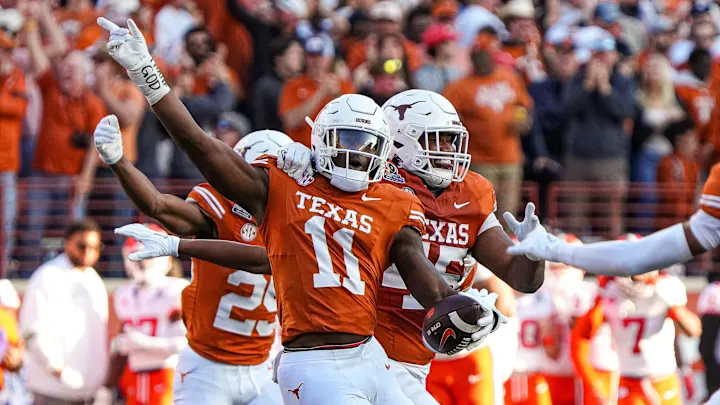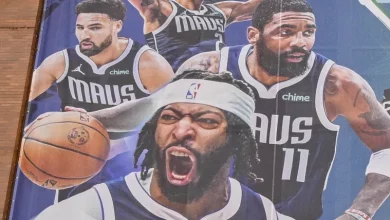There is speculation about Texas Longhorns selling advertising on their jerseys, while LSU is actively exploring ways to increase NIL-related ad sales to boost revenue.

College football, steeped in tradition and passionate fanbases, has historically maintained a strict stance on commercialization, particularly concerning uniforms, logos, and branding. However, recent developments in Name, Image, Likeness (NIL) policies and the evolving landscape of sports marketing have prompted schools and programs to reconsider their approaches to revenue generation and brand visibility.
Among the most discussed topics is the potential for college teams to sell advertising space directly on their jerseys. Notably, programs like the Texas Longhorns and LSU have been at the forefront of these conversations, with LSU actively exploring NIL-related ad sales and Texas contemplating jersey sponsorships. This shift signifies a broader transformation in college sports, balancing tradition with commercial opportunity.
This analysis delves into the motivations, implications, challenges, and potential future of jersey advertising and NIL-driven monetization strategies, focusing on Texas and LSU as case studies. It explores how these initiatives may reshape college football’s economic landscape, influence recruiting, fan engagement, and the core values of amateurism.
Historical Context: Tradition Versus Commercialization
The Tradition of College Football Uniforms
For decades, college football uniforms have been symbols of school pride, history, and identity. They feature school colors, logos, and sometimes iconic mascots, emphasizing a sense of unity and tradition. The NCAA and many conferences have maintained strict regulations concerning uniform modifications, with restrictions on commercial branding.
The Rise of Commercialization
In recent years, however, the landscape has shifted dramatically. The advent of lucrative media rights deals, lucrative sponsorships, and the NIL era—allowing athletes to profit from their personal brands—has opened avenues for increased commercialization. Schools are increasingly seeking ways to capitalize on their brand power, and uniform advertising offers a new revenue stream.
The Legality and Policy Landscape
The NCAA historically prohibited commercial logos and advertising on uniforms. But mounting pressure from conferences, schools, and commercial partners has led to evolving policies. Some states have passed legislation permitting jersey sponsorships, and the NCAA has shown signs of relaxing restrictions, though regulations remain inconsistent.
Jersey Advertising: Motivations and Opportunities
Revenue Generation
One of the primary motivations for schools to sell jersey ad space is financial gain. Jersey sponsorships can command significant sums, especially for high-profile programs with national visibility. For example:
Sponsorship Rates: Similar to professional sports, teams can negotiate deals with corporations willing to pay for logo placement.
Brand Visibility: Companies benefit from exposure during televised games, increasing their reach.
Funding for Athletics: Revenue can support facilities, scholarships, and operational costs.
Enhancing Fan Engagement
Some programs see jersey sponsorships as a way to connect with local businesses and communities, fostering a sense of partnership and local pride.
Attracting Commercial Partners
High-profile programs like Texas and LSU have extensive alumni bases and media exposure, making them attractive partners for companies seeking advertising opportunities.
LSU’s Active Exploration of NIL and Jersey Sponsorships
The LSU Approach
Louisiana State University has been proactive in exploring NIL monetization strategies. Reports suggest LSU is actively seeking to leverage NIL for financial gains, including:
Partnering with Local and National Brands: LSU has engaged in discussions with companies interested in NIL-related advertising.
Jersey Sponsorship Trials: The university has considered or experimented with jersey ads, viewing it as a way to generate revenue and modernize the branding approach.
Educational Initiatives: LSU has provided resources and guidance to athletes on NIL opportunities, aligning with broader institutional strategies.
The Rationale
LSU’s exploration is driven by multiple factors:
Maximizing Revenue: NIL and jersey ads provide additional income streams.
Competitive Edge: Being innovative with NIL can attract recruits and retain top talent.
Media Exposure: Sponsorships on jerseys increase visibility for brands and the program.
Challenges Faced
Despite enthusiasm, LSU faces hurdles:
Regulatory Uncertainty: NCAA and state policies are still evolving.
Fan and Tradition Concerns: Some fans and alumni oppose commercialization of uniforms.
Legal and Contractual Complexities: Ensuring compliance and fair deals require sophisticated legal frameworks.
Texas Longhorns: Considering Jersey Advertising
Current Status
As of now, Texas has been more cautious regarding jersey sponsorships, emphasizing tradition and institutional values. However, there is ongoing speculation and internal discussions about exploring jersey ads as part of broader NIL strategies.
Motivations for Texas
Revenue Needs: Texas, with its massive media market and passionate fanbase, recognizes the potential for significant advertising revenue.
Staying Competitive: To match or surpass other programs’ NIL initiatives, Texas may consider jersey advertising as a tool.
Innovative Branding: Texas could leverage its iconic Longhorn logo and colors in partnership with brands.
Potential Challenges
Preserving Tradition: Texas is known for its storied history, and some stakeholders may resist changes that alter uniform aesthetics.
Fan Backlash: Alumni and fans might view jersey sponsorships as commercializing college sports.
Policy and Regulation: NCAA and state policies could influence the feasibility of such deals.
Broader Implications of Jersey Advertising and NIL Monetization
Impact on the Amateur Status and NCAA Policies
The core debate centers around whether commercializing uniforms compromises the amateur status of college athletes and the integrity of college sports. Critics argue that commercial deals could blur the line between amateurism and professionalism, leading to legal and ethical concerns.
Influence on Recruiting and Competitive Balance
Jersey sponsorships and NIL deals can create disparities between programs. Wealthier schools or those with bigger media markets may attract lucrative deals, potentially widening the gap between Power Five and Group of Five schools.
Fan and Culture Perspectives
Some fans and alumni see jersey ads as a betrayal of tradition, fearing it could erode the unique identity of college programs. Others view it as an evolution necessary for financial sustainability.
Legal and Contractual Considerations
Implementing jersey advertising involves complex negotiations, licensing agreements, and compliance with NCAA, conference, and state regulations. Ensuring transparency and fairness is vital to prevent exploitation and maintain trust.
Ethical and Cultural Considerations
Maintaining the Spirit of College Sports
While commercialization offers revenue opportunities, maintaining the spirit of amateurism and educational focus is essential. Schools must balance profit motives with their broader missions.
Fairness and Equity
Equitable NIL opportunities are crucial. Jersey sponsorship deals, which may favor wealthier programs, could exacerbate inequalities and create perceptions of unfairness.
Protecting Student-Athletes
Ensuring athletes benefit fairly from NIL deals, including jersey sponsorships, remains a priority. Transparency, education, and legal protections are necessary.
The Future Outlook
Regulatory Evolution
The NCAA and Congress continue to debate and develop policies around NIL and commercialization. Clearer regulations will influence how and whether schools can pursue jersey advertising.
Technological Innovations
Advancements in digital and augmented reality could enable dynamic advertising, personalized jerseys, or real-time sponsorship activation, further transforming the landscape.
Strategic Partnerships
Schools like Texas and LSU will likely develop strategic partnerships with brands, balancing tradition with innovation to maximize revenue without alienating stakeholders.
Potential Models
Partial Sponsorships: Smaller patches or patches on alternate jerseys.
Event-Specific Ads: Temporary sponsorships during certain games or events.
Digital Integration: Virtual or augmented reality ads integrated with live broadcasts.
The discussions around jersey advertising and NIL-driven monetization strategies represent a significant shift in college football’s landscape. Programs like LSU are actively exploring and implementing NIL-related ad sales, including jersey sponsorships, recognizing the financial and branding opportunities they present. Texas, while more cautious, is also contemplating similar avenues as part of its broader NIL and revenue strategy.
These developments reflect a broader trend toward commercialization in college sports, raising questions about tradition, fairness, amateurism, and the future identity of college football. While jersey sponsorships can provide substantial revenue and enhance brand exposure, they also pose challenges related to policy, ethics, and stakeholder acceptance.
Navigating this landscape requires careful balancing—respecting the rich traditions of college athletics while embracing innovative revenue streams that can sustain and grow programs in an increasingly competitive environment. As policies evolve and technology advances, the presence of advertising on college jerseys may become more commonplace, fundamentally transforming the visual identity and economic model of college football.









